18 Things to Do in Kobuleti: Swamps, Empty Mansions & Fort
If you want a less bustling town on Georgia’s Black Sea coast, consider visiting Kobuleti. This small city, located about 27 km from Batumi, surprisingly has a fair share of attractions for its visitors. This complete things to do in Kobuleti guide provides a comprehensive list of sites, day trip ideas, cafes to eat, and essential travel tips to help you plan.
While Kobuleti is one of the largest cities on the Black Sea coast, unlike Batumi, it becomes a sleepy town during the off-season and comes back to life during the summer months.
Like many Georgians, I’ll admit that I thought there were only a few things to do in Kobuleti besides being a more affordable summer holiday destination than Batumi. However, I decided to debunk the myth and spend a few days playing tourist to rediscover the city.
My visit was at the beginning of September, a ‘velvet season’ as locals call it, meaning that it’s not as crowded as in summer, but the weather is still nice to swim in the Black Sea and enjoy sun rays while wandering its streets.

Kobuleti is the gateway to the Kobuleti Managed Reserve, part of Colchic Rainforests and Wetlands, enlisted as UNESCO World Heritage. Within this reserve lies the Ispani bog, an ecosystem of immense ecological importance and one of a kind in the whole of Georiga, making it one of the country’s most unique places to visit.
My Travel Essentials
Get an eVisa: Check if you need one at iVisa and fill out the form to get your eVisa easily.
Book a flight: I use Skyscanner or WayAway. The latter offers cashback with a Plus membership.
Airport transfers: Avoid the hassle of public transport and pre-book a transfer with Gotrip.
Reserve a hotel: My go-to platform for hotels or apartments is Booking.com.
Wine tours: Eat This! Tours offer premium wine tours. Use code RFD5 to get 5% OFF.
Hiking & culture tours: WT Georgia is the best for unique trips. Email them Red Fedora & get 10% OFF.
Find best-suited tours: For other tours, entrance tickets, and activities, I use Viator or Get Your Guide.
Rent a car: With affordable prices, Local Rent is one of the best car rental platforms.
Hire a driver: GoTrip is ideal for long-distance private transfers at very reasonable prices.
Debit card: I have Wise (an alternative to Revolut) for local money withdrawals without hidden fees or high exchange rates.
eSIM: To avoid heavy roaming fees, use Airalo or Saily. Compare prices and GB packages. Use BAIA2592 on Airalo and BAIAIR6152 on Saily to get 3 USD on both.
Travel insurance: SafetyWing covers health insurance and has add-ons for adventure sports and electronics theft coverage.
Disclaimer: Some of the links in this post are affiliate links, which means I may earn a small commission if you buy something through them—at no extra cost to you. It helps support my blog and lets me share real, first-hand travel tips. Learn more
Why visit Kobuleti?
Kobuleti, an idyllic coastal town, transforms dramatically during the summer when a rolling wave of tourists come here for holidays in July and August.
The rich history of Kobuleti spans many centuries and goes back to the Bronze Age, when nearby Tsikhisdziri and Bobokvati, now encompassed within the borders of Kobuleti Municipality, were territories of the Kingdom of Colchis, colonized by Greek settlements.

Mere kilometers away from the city, the Petra Fortress is tangible evidence of Ancient Lazica, representing one of Georgia’s most vital Roman-era archaeological sites.
In feudal times, the city was part of the Guria principality and was the largest slave trade market, where Turkish merchants from nearby coastal towns would come to buy enslaved people.
From the end of the 18th century, when Russia and the Ottoman Empires signed a Treaty of Küçük Kaynarca, Lower Guria and Kobuleti became part of the Ottoman Empire and were renamed Çürüksu, meaning ‘rotten water.’

After the Russo-Turkish War (1877-78), Kobuleti and the entire Adjara region became part of the Russian Empire and slowly became a resort town for the elite and aristocrats.
Tsar Alexander II gave prime seafront land to high-ranking military commanders as tokens of appreciation for their pivotal roles in defeating the Turks, who began developing the Kobuleti coastal strip with luxurious country houses.
Kobuleti’s healthy climate even made the headlines of the local newspaper Kavkazi, where doctors talked about the healing properties of air in Kobuleti.
When the Soviet government was established in Georgia, the aristocrats’ lavish houses came under the government’s ownership. Kobuleti became a climatic-balneological resort in 1923 with plenty of sanatoriums, new hotels, and boarding houses, mirroring the grandeur of Tskaltubo, most belonging to the Ministry of Defense.
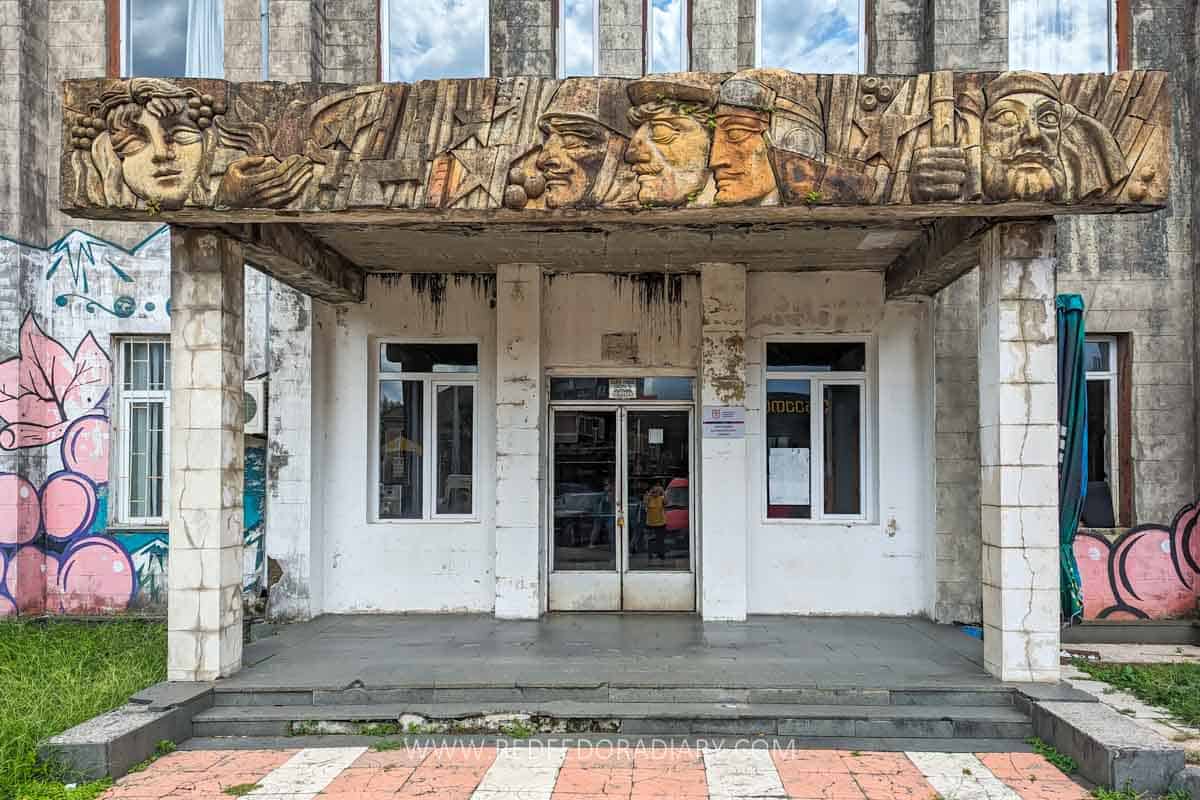
This brought locals for vacation and the annual ‘right to rest’ according to Soviet Law. Those with non-tuberculous respiratory, nervous, and cardiovascular system diseases also came here for treatments.
During the Soviet period, Kobuleti had cotton weaving, canning, tea factories (read about Georgian tea), and various cattle and agricultural farms.
After the collapse of the Soviet Union and the devastating War in Abkhazia from 1992 to 1993, several thousand internally displaced persons (IDPs) temporarily found refuge in the newly abandoned hotels of Kobuleti.
Consequently, both Batumi and Kobuleti emerged as alternative beach destinations to Sokhumi, Gagra, and Pitsunda and continue to be immensely popular among locals and tourists from neighboring countries like Armenia, Azerbaijan, and Turkey.
The best time to visit Kobuleti
Choosing the perfect time to visit Kobuleti can significantly influence your experience. If you desire to bask in Kobuleti’s vibrant ‘beach resort’ ambiance, then the summer months, stretching from July through the first two weeks of September, are your prime opportunity.
During this period, the city springs to life as the bustling beachfront promenades and lively beach bars are at their peak.
However, if you want to visit Kobuleti in its peaceful times, the off-season is your best bet – spring or autumn. However, note that this time of year has occasional rain and brisk winds. And while most residents stay here year-round, many hotels and guesthouses close, as do dozens of cafes and restaurants.
Things to do in Kobuleti Map
Here is a detailed Google Maps list of all the spots and locations mentioned in this guide. You can save the list and refer to it whenever needed.
18 best things to do in Kobuleti
Kobuleti’s rich history offers many activities to entertain the curious traveler – from a few Soviet sanatoriums to intricate mosaics, from local museums to natural wonders. Spending one full day in the city is enough, but if you want to explore neighboring sites, you may want to add a day or two to your plans.
Kobuleti is a very walkable flat city. However, most attractions are spread out within its two main roads parallel to the coast. Local taxis are everywhere if you need one; the Bolt taxi app also works here. And there’s Bus No.1 that goes along Aghmashenebeli Str.
We walked everywhere and only ordered a taxi to take us to the far ends of the city.
While I plan on updating this guide as needed, if you find any information provided here changed, I’d appreciate it if you reached out and left a comment below.
Visit the tiny Kobuleti Museum
One of the things to do in Kobuleti is to venture to the heart of Kobuleti for a visit to the local history museum. This modest exhibition offers a window into the city’s rich heritage with a collection of archaeological artifacts, clay amphorae, and coins, to name a few.
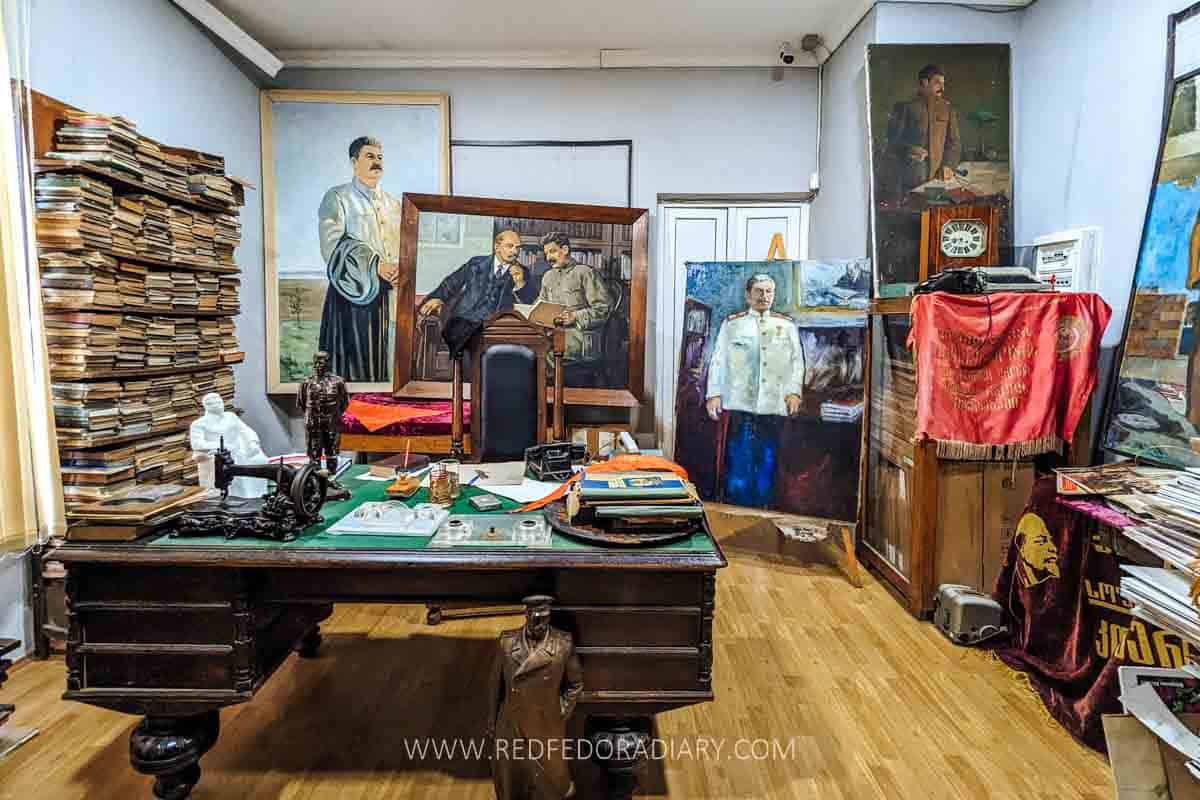
Go downstairs from the main exhibition hall to see the remnants of the basreliefs and the ethnographical corner. Upstairs is another space dedicated to the Soviet era with many posters, paintings, flags, a desk, and a stationary.
- Opening hours: Tue-Sun 10 am – 6 pm; Closed on Mondays
- Entrance fee: adults – 5 GEL; both locals and foreigners
Explore the Kobuleti Managed Reserve
Stepping away from the sea lies the mysterious Kobuleti Managed Reserve, where marshy wetlands take center stage, weaving a fascinating landscape.

With 770 hectares of natural wonder, the national park is a vital sanctuary for the region’s biodiversity, safeguarded by the Ramsar Treaty as a ‘wetland of international importance’ from 1971.
In 2021, Kobuleti Managed Reserve became a UNESCO World Heritage Site as part of the Colchic Rainforests and Wetlands, along with Kolkheti National Park in Poti, Kintrishi Strict Nature Reserve, and Mtirala National Park.
One of the most unique places to visit in Georgia, Kobuleti Managed Reserve is home to the ecosystem tracing its origins to the Quaternary period’s Ice Age. The reserve is particularly renowned for its lush peat mosses, predominantly showcasing a captivating variety of sphagnum species, which gracefully adorn this unique landscape.
Here, the peat moss remains uncovered by water, serving as a natural sponge that can absorb rainwater and expand to 25 times its weight.
During my very first visit to the Kobuleti Managed Reserve a few years ago, I was accompanied by staff members who, to demonstrate its unique characteristics, pulled out the moss and squeezed it in front of me, adding that once you place this moss back, it will regenerate itself.

When squeezed, the moss produces the purest, cleanest water, unveiling its remarkable filtration capabilities. Perhaps even more astonishing is this unique environment’s role in protecting Kobuleti from flooding during heavy rainfall.
To explore the rare peat moss landscapes of Ispani I and Ispani II, a well-laid path and a brief elevated boardwalk guide you through the reserve’s heart. As you traverse this picturesque route, it leads you to a lookout tower that offers the perfect vantage point for capturing breathtaking aerial photographs of this enchanting landscape.
- Opening hours: always
- Entrance fee: FREE
How to visit Kobuleti Managed Reserve:
Take a taxi, Bus No.1, from Agmashenebeli Ave., or walk towards the intersection of Aghmashenebeli and Baratashvili (the exact spot is included on my Google Maps list). Then, follow the signs for a few minutes to the park entrance.
Drink coffee at Livi Coffee & Bar
To kick-start your day with a delicious cup of specialty coffee, head to Livi Coffee & Bar on Aghmashenebeli Street.

This minimalist place offers classics, flat white and raf coffee, and cold drinks such as espresso tonic or banana latte, to name a few. They also have matcha latte, cocoa, tea, and other non-caffeine drinks.
Even though they don’t have a food menu, they do offer cakes, snacks, cookies, and pre-packaged sandwiches and salads.
Enjoy a relaxing walk on the coast
Kobuleti’s extensive beachfront with black pebbles and rugged rocks stretches around 10 km and has a sandy coast in some parts.
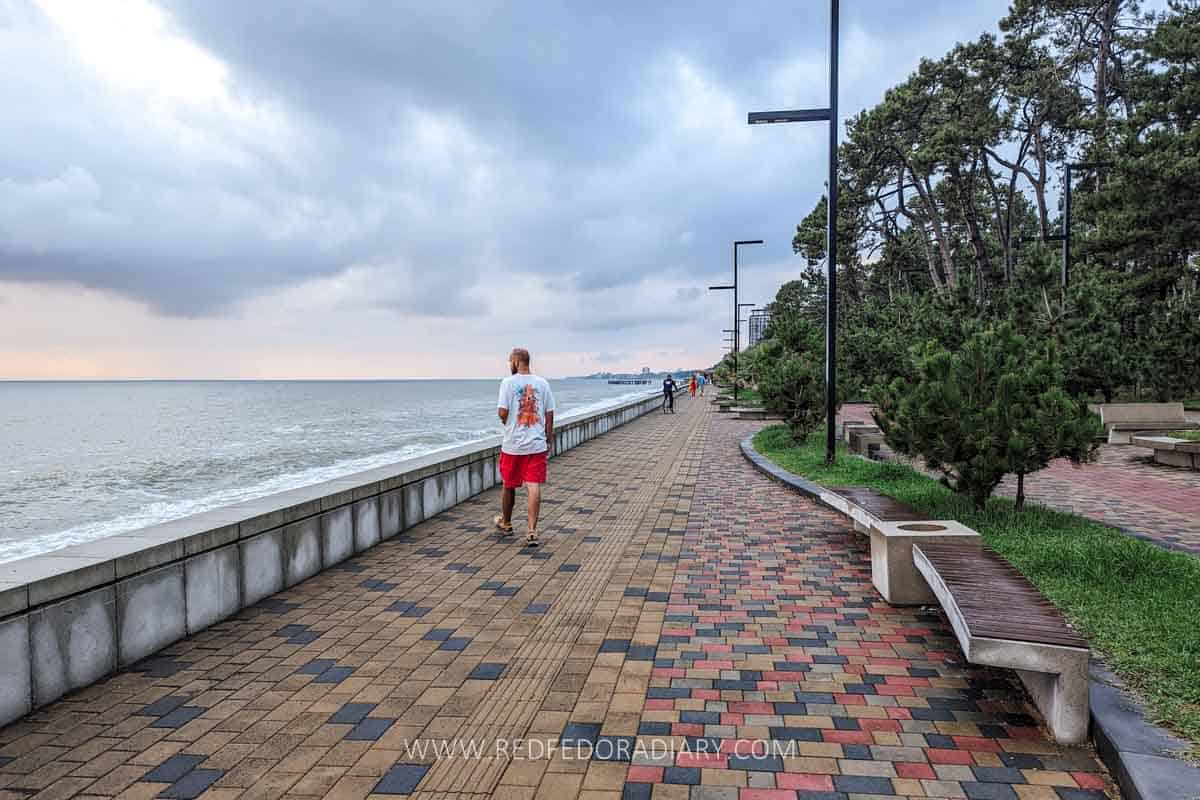
One of the best things to do in Kobuleti, either in the morning or evening, is to enjoy a long leisurely walk here as it offers sweeping vistas that extend to Tsikhisdziri, Mtsvane Kontskhi, or ‘Green Cape,’ and the cityscape of Kobuleti itself.
Kobuleti Boulevard, relatively new and carefully designed, meanders along the waterfront with broad sidewalks, bicycle lanes, and artistic sculptures. There are staircases along the way, giving access to the shoreline below.
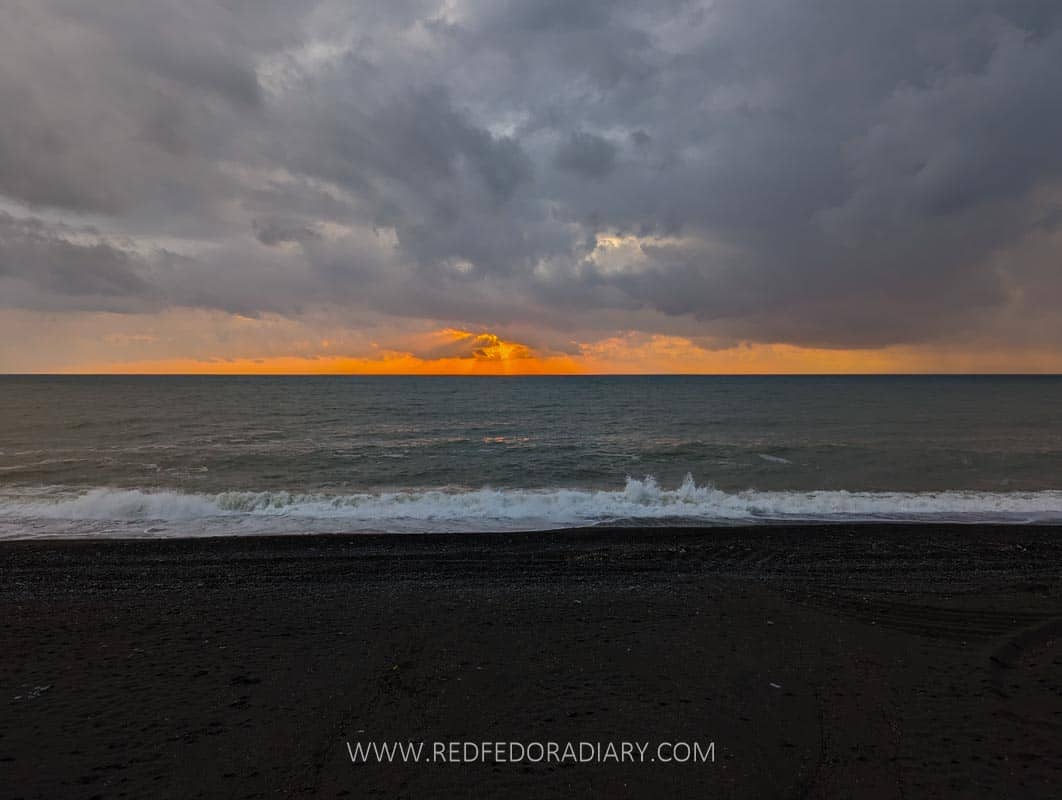
The Boulevard leads to Kobuleti Central Park and the iconic pier, which sadly misses a few flooring sections. While we saw some people walking on the dock, it looked unsafe from Boulevard, so we didn’t risk it.
See the former sanatorium
Unlike Tskaltubo, almost all the sanatoriums in Kobuleti vanished over the years, giving space to new buildings. There are heavy development and construction projects, so many long-standing abandoned buildings are fenced off or demolished.
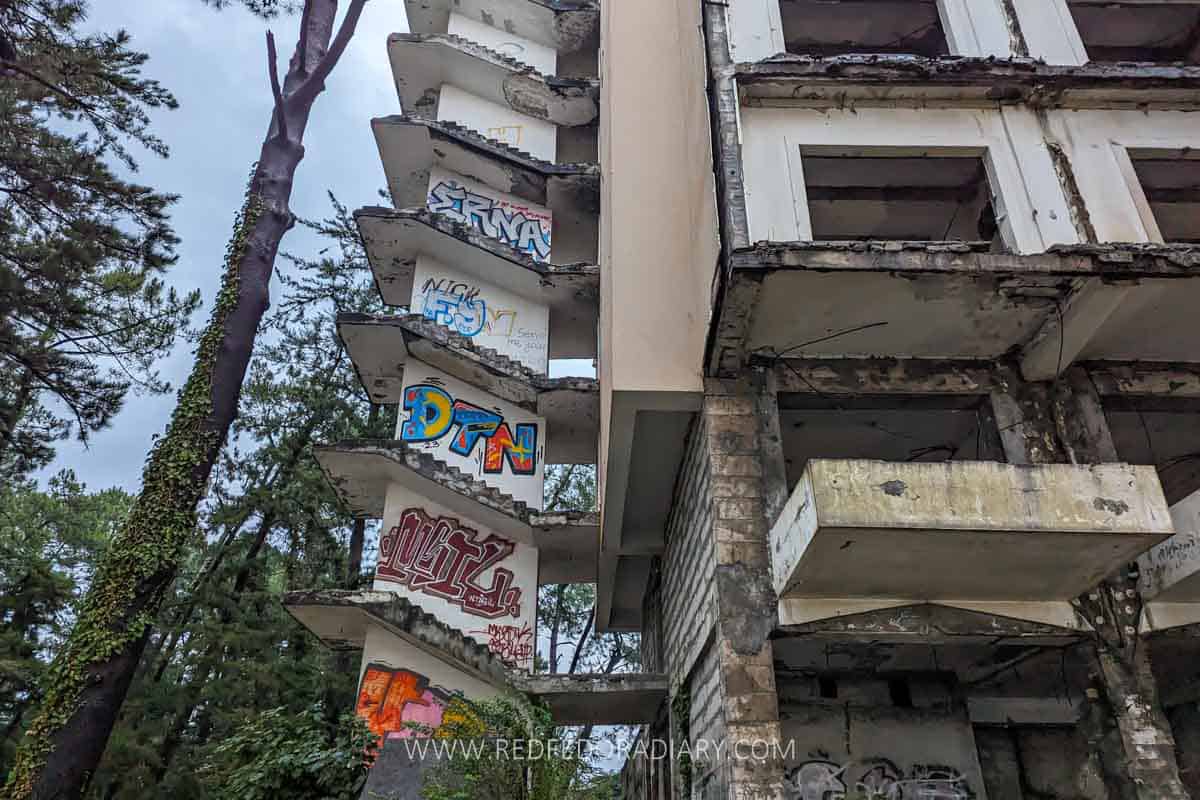
We could only find one abandoned building while walking on the Boulevard. The ten-story hotel standing right at the coast is emptied out. The external staircase is intriguing, with a few graffiti adorning its walls, while the entrance from Aghmashenebeli Street still features some mosaics (see below).
Find a few remaining Soviet mosaics
You might already know that Soviet-era mosaics are my weak spot, so I am always on the lookout when visiting cities in Georgia. They are the relics of a bygone era of grandeur and artistic expression.
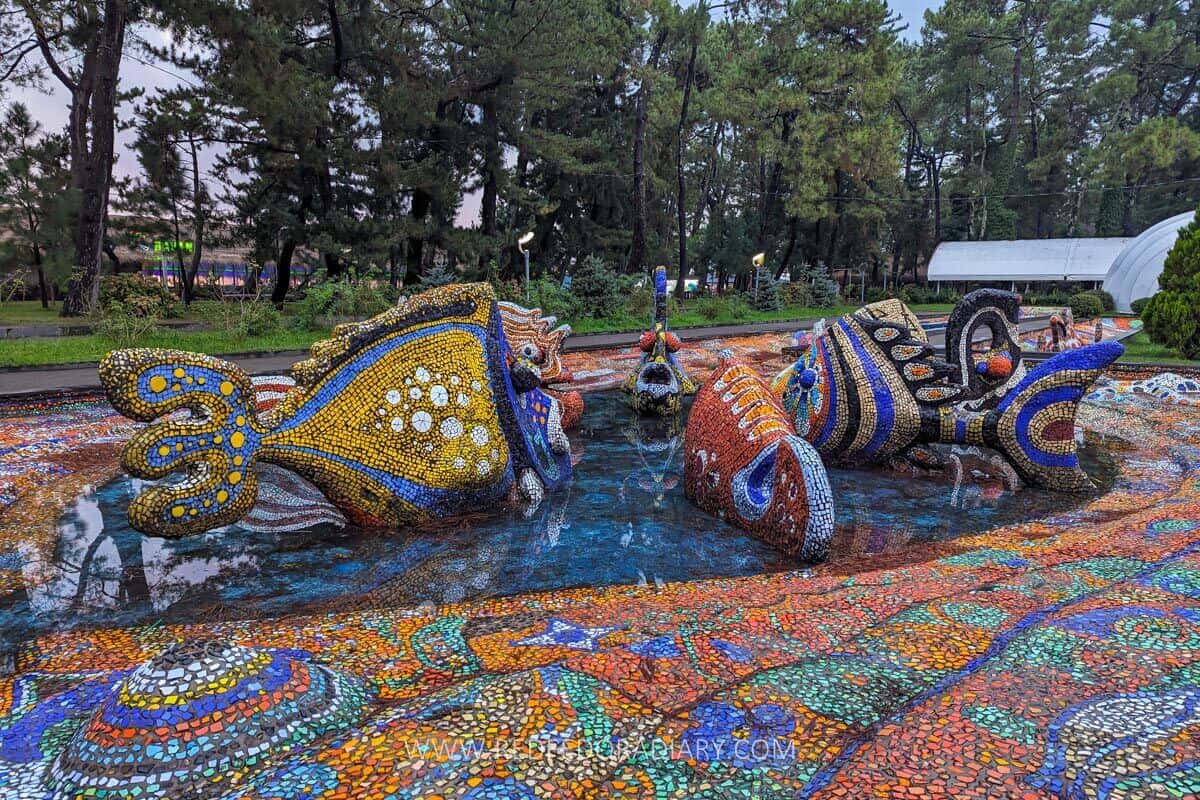
Much like the abandoned sanatoriums and hotels, many mosaics I have previously seen and knew about were absent on my last visit in September 2023. I could only find a handful of them that I included in my Kobuleti travel guide list on Google Maps above.
The Kobuleti Central Park is home to a gorgeous seaworld-themed massive fountain showcasing different three-dimensional fish, octopus, and crab. Unfortunately, I found only information about its author – Ilia Pesvianidze – the date is unknown.
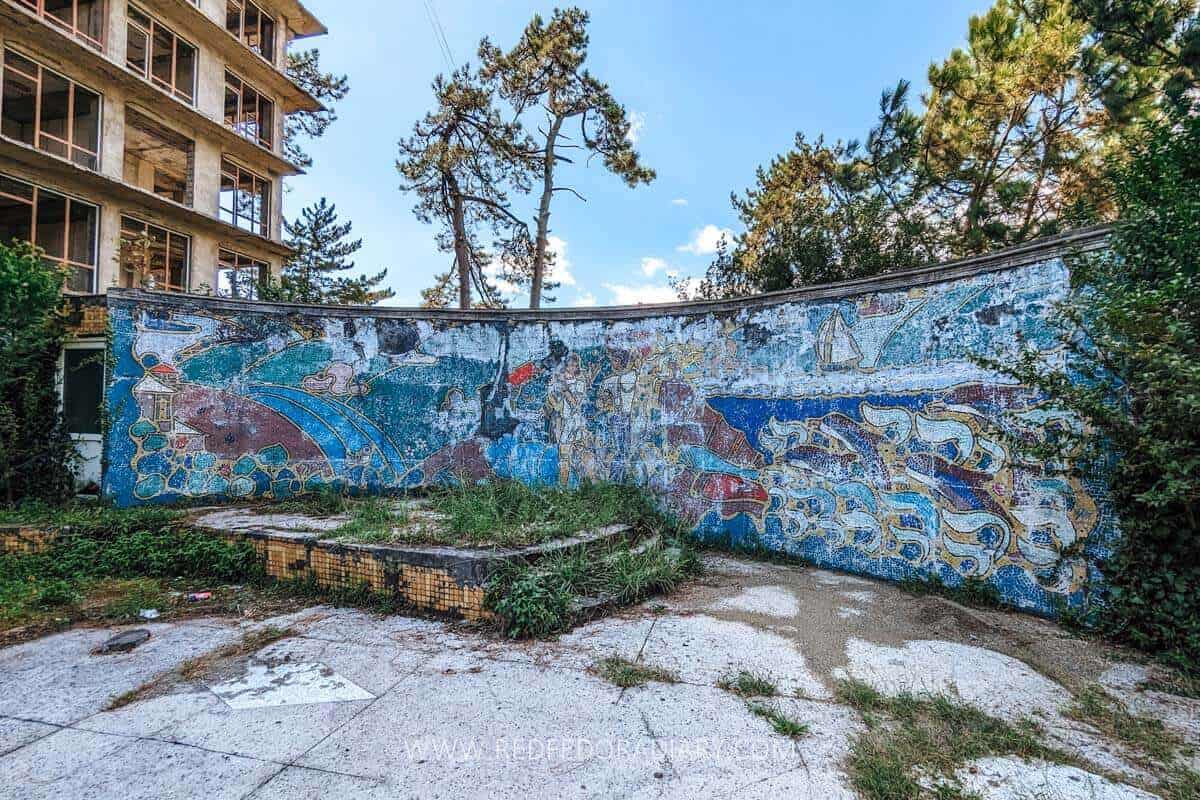
At the entrance of the above-mentioned abandoned hotel is another sealife-themed mosaic standing intact; however, the overgrown plants are taking over and covering half of it. Sadly, both the author and the date are unknown.
The courtyard of the Marshal Resort also hides a panoramic mosaic accessible from the main street. There will be a guard, but if you tell him you want to look at the mosaic, he’ll let you in.
The mosaic isn’t in good shape, with scenery barely visible. It clearly shows a coastal town with a girl and a boy in the center, dancing dolphins coming out of the sea waves on one side and a town on the other, while a yacht sails away in the background.

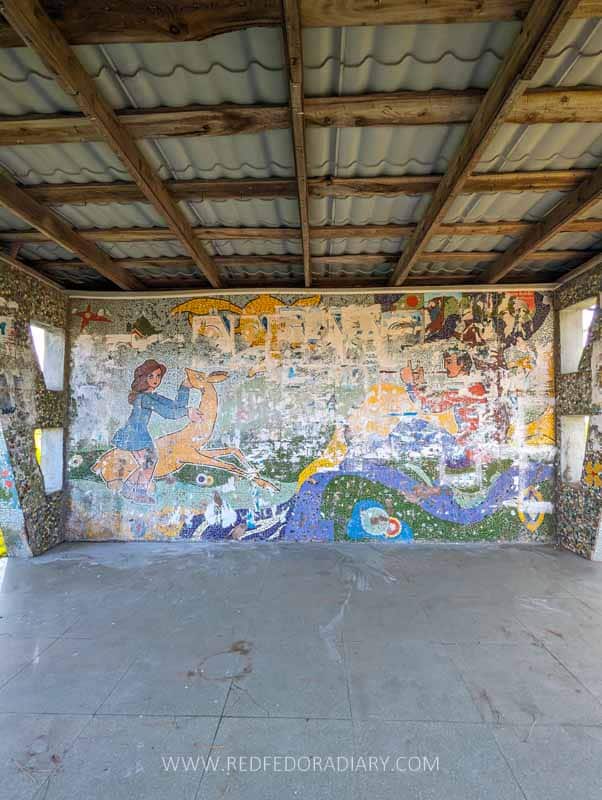
North of Kobuleti towards Shekvetili, we found another Soviet-era mosaic adorning a bus stop. There was a guy with a bucket full of water inside the bus stop that I hadn’t paid attention to. When I took photos of it, he came up and showed the picture of the mosaic a few hours before my arrival. Apparently, it was covered in posters, and he cleaned it as much as possible.
On our way to the Kobuleti Market, we also found a building with Soviet-era bas-relief (the exact pin is on the Google Maps list).
Have breakfast at Smith’s Bar
Only a handful of places offer breakfast in Kobuleti, probably because it has never been a Georgian culture to go out for breakfast (which is now changing with younger generations). And most of the places that do offer breakfast open slightly late in the morning.

We found Smith’s Bar to offer two versions of the breakfast menu – one with omelet roll and another with boiled eggs. The plates came with cheese, croutons, olives, and slices of cucumber and tomato.
Buy local produce at the market
One of the things to do in Kobuleti is to browse the market stalls for fresh produce of regional delicacies, churchkhela, Georgian tea, pickles, honey, spices, and jams, along with fresh fruit and vegetables.

We found our favorite imported Turkish black and green olives, a five-litter tin box of olive oil, and pickled chilies for much more reasonable prices than in Tbilisi.
Don’t forget to try Iakhni
Adjarian cuisine boasts a splendid culinary tradition that resonates with abundant dairy products and is influenced by Ottoman heritage. Kobuleti, in particular, takes pride in its culinary masterpiece, the flavorful dish iakhni.

This rich beef stew seasoned with a flavorful blend of ground walnuts, onion, garlic, and spices is reminiscent of the renowned Megrelian kharcho, but has a different flavor profile that sets it apart.
Traditionally considered a dish for celebrations and weddings, you can now savor iakhni at restaurants in Kobuleti and Adjara regions.
Try it either at Chero restaurant or Sakalmakhe (see below).
Dine at Afra
Afra is one of the best restaurants in Kobuleti, and we loved dining at it. The staff was friendly and welcoming, and the food was delicious.

The restaurant is located on Aghmashenebeli Str. and boasts a diverse menu with fish, salads, hot meals, pizza, Khachapuri, and appetizers.
We had red mullet, which came in a huge pan, and Ojakhuri with mushrooms. We also ordered their specialty Afra bread, which resembled a thin pita or nan bread.
Ride a roller coaster at Tsitsinatela Amusement Park
For a dose of adrenaline and family-friendly fun, head over to Tsitsinatela Amusement Park. This park has thrilling roller coasters and whimsical carousels to enjoy near Kobuleti.
Whether you’re traveling with kids or love such parks, Tsitsinatela is the perfect place to have fun.
Once here, you can also pop into Georgia in Miniature Park to see the historically and culturally significant sites in their petite forms.
Admire wooden mosques of Adjara
If you are looking for off-the-beaten-path things to do in Kobuleti, visiting the wooden mosques of Adjara should be right up your alley. They hold a unique and significant place in the region’s cultural and architectural heritage.

These exquisite structures, crafted from wood with masterful artistry, are architectural marvels and sacred spaces that have played an important role in the local Muslim community.
While most of these gorgeous mosques are scattered in the highland villages of Upper Ajara, I found one near Kobuleti, in the village of Kvirike, around 10km away.
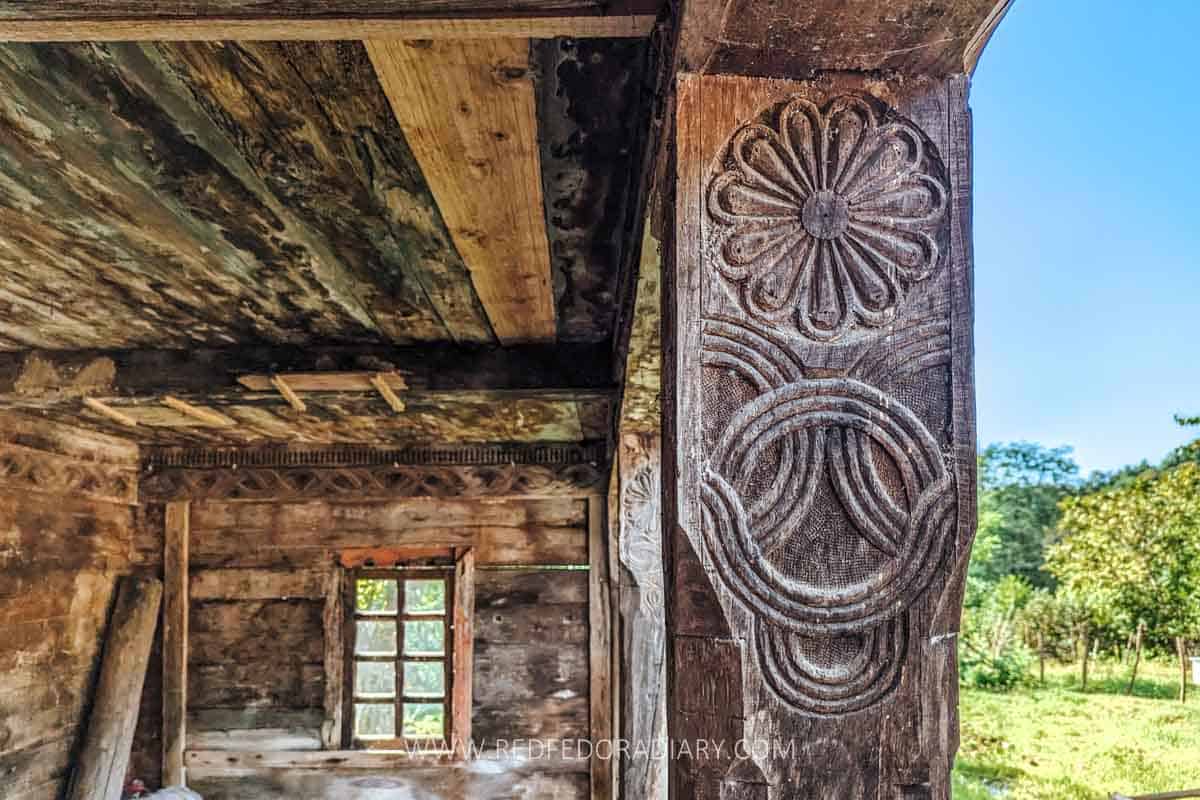
This two-story religious building was constructed by Laz artisans in 1865- 1866, making it one of the oldest wooden mosques in the region. From the outside, it looks like a typical Adjarian residential house, while from the inside, it has traces of ‘Darbazuli’ layout (native to the Samtskhe-Javakheti region) with its dome-like ceiling.
Various parts of the mosque (door, pillars, railings, etc) have traces of Georgian ecclesiastical and vernacular architecture. The carvings, both on the door and pillars, are absolutely stunning.

It differs significantly from the other wooden mosques I have seen in Ghorkomi, Tago, and Khulo.
Sadly, the mosque was locked during my visit, and I could only peek inside from a tiny window. My taxi driver and a young man waiting for the bus near the mosque told me that it is usually open for Friday prayers, making it the only day to see it from the inside (obviously outside Friday prayer times).
Eat fresh fish at Sakalmakhe
Sakalmakhe is a Georgian word for ‘trout farm’. The venue, south of Kobuleti towards Batumi direction, is a local favorite to eat fresh fish right from the pool.

Their diverse menu offers a wide choice of fish and other Georgian meals. They have salmon, trout, red mullet, seabas, dorado, and saurels. The price for your fish is determined by the kilograms. While they will try to catch a small one, they won’t cut it to the exact weight.
We ordered grilled salmon on our visit, and it was plenty for two. The total weight was slightly over 2kgs.
Wander through the mysterious Petra Fortress
Step back in time at the iconic Petra Fortress perched on a rocky hill overlooking the Black Sea. This ancient marvel proves Georgia’s rich history and dates back to the 6th century, witnessing centuries of battles and conquests.

As you explore its well-preserved ruins, climb to the area’s highest point for panoramic views of the sea and the surrounding landscape. The history and views alone make Petra Fortress one of the top things to do in Kobuleti.
To visit Petra Fortress, hop on Batumi-bound marshrutka and tell the driver to stop at Petra. The price should be 3 GEL.
- Opening hours: every day, 10 am – 6 pm
- Entrance fee: 5 GEL
Hunt down abandoned mansions in Tsikhisdziri
Venture a short distance from Kobuleti, and you’ll stumble upon Tsikhistsiri, a town that feels like it’s been frozen in time.

Tsikhisdziri is home to a collection of abandoned mansions, each with its unique architecture, most likely been there since Tsar Alexander II ordered to give the coastal strip of Kobuleti to the best commanders-in-chief who distinguished themselves during the Russo-Turkish War of the 19th century.
Some of these mansions are undergoing renovations and are fenced off, with guards and workers not letting anyone venture in.
Luckily, on our visit, no one was at these mansions, and we managed to walk through admiring the beautiful architecture I had no idea Tsikhisdziri had.


Some even have private property signs saying ‘no transpassing.’ The locations and pins of the mansions we visited are on my Google Maps list.
Unfortunately, I could not find much information on these lavish buildings, but simply wandering the premises is worth a journey.
As you walk through the overgrown gardens and peep through windows and doors, you’ll catch glimpses of a forgotten era when these mansions embodied luxury.

Small favor: If you also venture into Tsikhisdziri in search of these mansions and find a different situation, I will be grateful if you reach out to me (either on social channels or comment below) before I update this post with more relevant information.
Similar to Petra Fortress, to get to Tsikhisdziri from Kobuleti, you must take a marshrutka to Batumi and hop off near the entrance turn of Castelo Mare Hotel (see the exact spot with a note on my map above).
Spend an afternoon at Shukura
After the hunt of these mansions, it’s time to relax, enjoy, and dine at Shukura – a multifunctional space with a restaurant and an open-air pool in Tsikhisdziri.

Housed in a former sanatorium of the same name, Shukura is another brand child of the Adjara Group (owners of the Rooms Hotel chain, including Kokhta Bakuriani, Fabrika Tbilisi, Stamba Hotel & Cafe, Udabno regenerative farming, etc).
During our visit, the pool area was already closed for the season, and I could only peep inside to take a few photos. In its peak season, there’s a poolside bar for the visitors. In 2024, the management plans to renovate the sanatorium’s old rooms into hotel rooms.


The Shukura cafe is separate from the pool area, located down the stairs leading to the Black Sea coast. The seating area and the kitchen are spread inside the former sanatorium’s staff member buildings. The open kitchen with the massive brick oven is something to behold. I loved staring at chefs prepping the meals.
This seasonal cozy eatery is extremely popular during summer, whipping up flavorful regional and continental staples, such as Adjaruli Khachapuri, muscles in Thai sauce, Foccasia, salads, and appetizers. Their cocktails are also quite delicious.
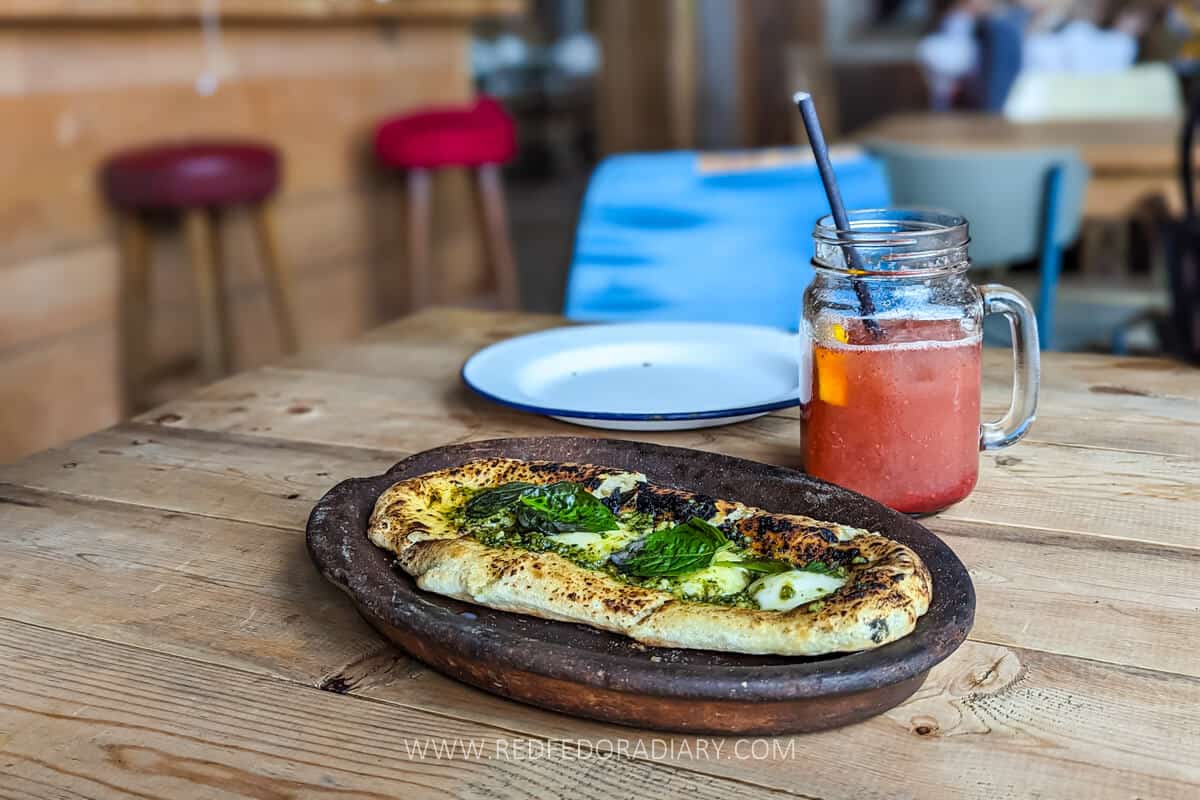
Even though it was a rainy day on our visit in September, the warm and welcoming atmosphere added an extra layer of charm to the place.
If you follow the stairs down to the coast and then follow the banana tree line, you’ll find the so-called Tsikhisdziri hidden beach, also part of Shukura that has sun lounges on the platform over the huge rocks. Two stairs on the opposite sides have direct access to the sea.
See the abandoned house of a Chinese tea grower
In the small coastal town of Chakvi, you’ll find remains of an abandoned house that once belonged to the legendary Chinese tea grower Lau Dzhen Dzhau from Zhejiang province.

This house is not just a neglected structure; it’s a piece of history that carries the legacy of the man who played a pivotal role in introducing and assisting in tea production on the lush terrains of Georgia. See my guide to Georgian tea to learn more about him and the tea industry.
Read also: Renegade Tea Farm – how a company resorted Soviet tea farm, restarting the tea production and offering tours to the visitors.
The abandoned house nestled at the Black Sea coast has an idyllic scenery and gorgeous views of the sea in front. The castle-like building now stands empty without a door or windows and is covered by overgrown plants.
Inside is full of trash and cow excrement. Everything that was once valuable is gone; only the traces of the fireplace exist, and even the staircase leading to the second floor is gone.


One very symbolic item adorns the floor of the house – a triple tea leaf – which, according to George Bitadze from the Tea Museum in Tbilisi, was added afterward and is not original.
Several years ago, some funding was allocated to restore the house and turn it into a social space. The renovation works are visible today; however, for whatever reason, it was paused, leaving this cultural relic abandoned once more.
From Kobuleti to Chakvi, take a Batumi-bound marshrutka and stop it once you notice the building on the main highway.
Don’t miss the former palace of Romanovs
A few meters from Lau Dzhen Dzhau’s house, you’ll find a former royal palace that belonged to the Romanovs. This is where Georgian tea was produced specifically for the Russian Imperial family.
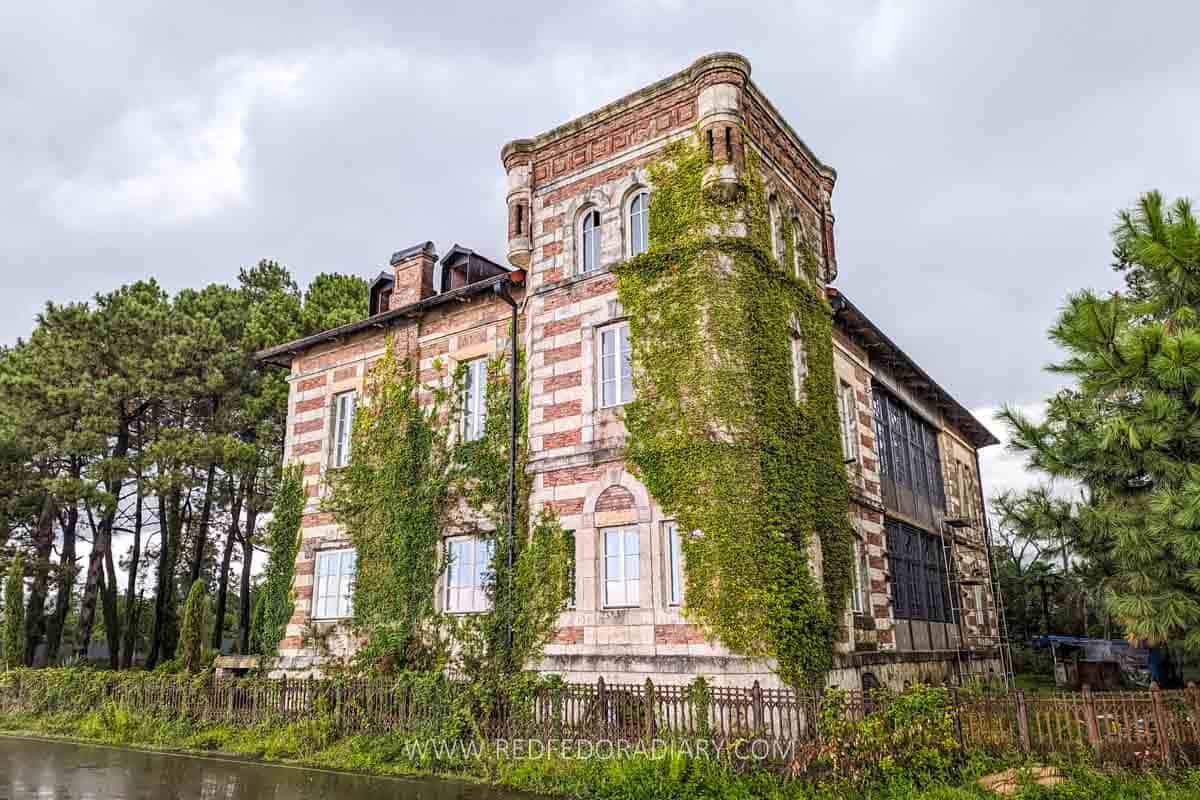
While I believed it was abandoned based on the photos I saw on Google Maps, upon walking up close, we realized that someone had bought it and lived there. It is almost fully renovated, with at least dozens of surveillance cameras on its facade.
This red brick and white stone building has intricate details and glass-covered hallways we call shushabandi. The creeping plant adds another appeal to its overall beauty.
Other day trips from Kobuleti
The location of Kobuleti enables you to explore the neighboring Guria region or do a bit longer day trips to explore other parts of Adjara. Here are a few more suggestions:
Shekvetili: located around 10km from Kobuleti, Shekvetili boasts magnetic sandy beaches, an intriguing Musicians Park with statues of Georgian and international artists, and a Dendrological Park.
Batumi: while you should definitely spend more time in Batumi rather than make a day trip from Kobuleti, I am still including it as an option for those who don’t have much time and would love to see the quirky, unusual, and fascinating town in the Black Sea. Refer to all my Batumi guides for more information.

Poti: located about 55-minute drive from Kobuleti, Poti is the town in Samegrelo known mainly for its seaport and mosquitos among locals. However, there’s much more to the city, including being the first ever city in Georgia developed based on a plan mirroring Parisian layout, gorgeous neo-Gothic architecture, and Kolkheti National Park (also part of UNESCO World Heritage Site). It barely gets any visitors, making it a perfect off-the-beaten-path destination. For more information, refer to my Poti travel guide.
Where to stay in Kobuleti
Kobuleti offers many lodging options, so finding a place to stay should be easy. However, if your visit falls within the summer months, between June and September, it’s advisable to book well in advance, ensuring you secure the perfect accommodation for your coastal escape.
Marshal Resort: with unique architecture and a beautiful green garden, the hotel offers rooms at a prime location right on the seafront. The rooms are simple yet quite spacious. With its terrace overlooking the sea, you can enjoy gorgeous sunsets.
Magnolia Hotel Agmashenebeli: located just 200 meters from Kobuleti Beach, the hotel offers a range of amenities, including a seasonal outdoor swimming pool, a garden, and a terrace.
Georgia Palace Hotel & Spa Kobuleti: this contemporary hotel boasts a vast outdoor pool, an open-air restaurant, and rooms with balconies that offer breathtaking vistas of the Black Sea or the scenic Ajarian Mountains.
The elegantly designed, air-conditioned rooms are equipped with modern amenities to enhance your comfort.
Bamboo Garden: this stylish hotel is a mere 800 meters from Kobuleti Beach, featuring a seasonal outdoor swimming pool and non-smoking rooms all set amidst a peaceful garden. Additionally, it also has a private beach area. The well-appointed rooms in pastel colors include private balconies with beautiful sea views.
→ None of them suit your needs? See more hotels in Kobuleti here.
How to get to Kobuleti
Kobuleti enjoys excellent connectivity with neighboring cities along the Black Sea coast, making it easily accessible for travelers. If you plan on visiting Kobuleti and western Georgia, I recommend renting a car at LocalRent for affordable prices and flexibility. Alternatively, you can opt-in for a private transfer with GoTrip for unlimited stops along the way, which is more affordable than it sounds.
And in case you want to use public transport, here’s a breakdown of how to reach Kobuleti from key locations:
Tbilisi to Kobuleti: For travelers coming from Tbilisi, you can hop on the fast train to Batumi, which makes a stop at Kobuleti Railway Station. There are multiple daily departures, with a second-class ticket priced at 35 GEL. The railway station in Kobuleti is a 15-20 minute walk from the town’s city center. Direct marshrutkas to Kobuleti from Didube Bus Station (Okriba) takes around 5:30 to 6 hours. Tickets cost 30 GEL.
Batumi to Kobuleti: To travel from Batumi to Kobuleti, go to the Church of the Holy Spirit and take a marshrutka to Kobuleti. The price is 3 GEL, and the journey takes around 40-45 minutes.
Kutaisi to Kobuleti: If you’re starting your trip from Kutaisi, head to the Kutaisi Central Bus Station. From there, take a bus bound for Batumi, departing every hour between 9 am and 5 pm. Inform the driver that you’d like to disembark in Kobuleti. The trip takes a little over two hours, and the fare is 15 GEL.
More Georgia posts
My Favorite Travel Resources
To ease your travel planning, check out all the posts about Georgia travel. Additionally, here are some of the websites and services I use when preparing for my next adventure anywhere in the world.
✈ Book affordable flights on Skyscanner, a platform that shows the best flight deals.
🚫 Get compensation for up to 700$ with Airhelp if your flight was canceled or delayed within the last 3 years.
🚗 Rent a car at Local Rent for affordable prices and convenient service.
❣ Pre-book a private car transfer with GoTrip from Tbilisi Airport to your hotel or any other city across Georgia.
💻 Get a VPN from Surfshark to protect your devices from hackers when using public Wi-Fi when traveling.
📱 Install the Airalo app, which provides local eSIMs for a more affordable internet connection when traveling. Get 3 USD with code: BAIA2592.
💸 Use Wise to withdraw money in local currency without hidden fees and avoid high exchange rates. On top, you might get a Visa or Mastercard debit card.
🍷 For some of the best, expat-designed wine tours check out Eat!ThisTours. Get a 5% discount with code RFD5.
🏨 Find budget-friendly deals on all sorts of accommodation types on Booking.com.
🩺 Buy the most flexible and budget-friendly travel insurance, SafetyWing, covering COVID.
☀ Book in advance some of the best city walks, cultural experiences, and day tours to maximize your stay and experience here.
